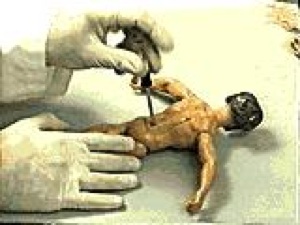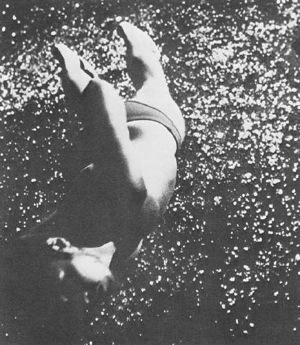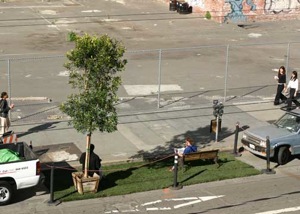On October 19, 2009, performance artists, The Yes Men, held a fake US Chamber of Commerce press conference at The National Press Club. A small assembly of journalists listened attentively as "Hingo Sembra," posing as a Chamber official, announced that the behemoth business federation had revised its stance on Climate Change, and would discontinue lobbying against the Kerry-Boxer bill (which calls for significant reductions in U.S. carbon dioxide emissions). Moments later the real Chamber Spokesperson, Eric Wohlschlegel, burst through the doors of the conference room, breathlessly proclaiming the speaker to be a fraud! After a few dramatic seconds of Will the Real Chamber of Commerce Official Please Stand Up Game, Mr. Wohlschlegel made a strategic error by suggesting that the press direct questions to him, not the imposter. "Is the position of The Chamber of Commerce that Climate Change does not exist?" one journalist demanded. Mr. Wohlschlegel opted to ignore the question. He realized too late that any reaction would draw even more attention to the ne’er-do-well policies being exposed, and therein lies the brilliant quandary, which has become a winning tactic of The Yes Men.
From their Lettrist and the Situationist roots, artists continue to generate some of the most death-defying, dynamic stunts of political activism. Assembled here is what I consider to be art activism’s "greatest hits."
The Eternal Frame, Ant Farm and T.R. Uthco, 1976
This seminal work of video art documents the art collectives Ant Farm and T.R. Uthco, as they tastefully re-enact the John F. Kennedy assassination at Dealey Plaza (a mere 12 years after the actual event). With painstaking mimicry of the Zapruder home movie, the actors manage to make multiple loops in their convertible, repeating the assassination scene over and over, drawing a larger crowd of spectators with each rotation. To their surprise, no authorities intervene except to allow them to pass other traffic. Eyewitnesses, interviewed by the Videofreex, were either moved to tears or tourism, underscoring the power of the media image to create collective memory and myth.
Dow Chemical and the Bhopal Disaster, The Yes Men, 2004
On the 20th anniversary of the Bhopal Disaster, a fake Dow Chemical representative, "Jude Finisterra," appeared on BBC television stating that the company accepted full responsibility for the long-ignored Union Carbide (now Dow) chemical disaster of 1984 which killed thousands and left over 120,000 requiring lifelong care in Bhopal, India. Mr. Finisterra, in actuality a member of The Yes Men, was not revealed as an imposter for several hours – long enough for the story to be picked up elsewhere, and for Dow’s stock to drop by $2 billion.
First Amendment Mob, The Reverend Billy and The Church of Stop Shopping, 2004
Seizing the power of the mobile phone as publicly sanctioned platform for loud conversations, The Reverend Billy and The Church of Stop Shopping (a fake minister with a real mission to stop corporate greed) gathered weekly during 2004 at prime rush hour at the World Trade Center PATH station. Interspersed among the financial district employees who were truly having cell phone conversations, were dozens of other fake commuters reciting the First Amendment into their cell phones: "Congress shall make no law respecting an establishment of religion, or prohibiting free exercise thereof; or abridging the freedom of speech, or of the press, or the right of the people peaceably to assemble, and to petition the Government for a redress of grievances." The group was sending their telephonic messages (via media outlets which picked up the story) to the Bush Administration that 9/11 could not be leveraged to manipulate Constitutional rights.
Ed Keinholz vs. TWA, Ed Keinholz, 1968
Everyone has experienced that moment when baggage claim did wrong by us, and we fantasized our elaborate revenge. Artist Ed Keinholz did just that after TWA insisted he check a carefully packed Tiffany lampshade (rather than carry it on as the artist demanded). On arrival at baggage claim, the lampshade was damaged irreparably. To add insult to injury, TWA claimed that Keinholz packed a damaged lamp in order to make an insurance claim. After months of waiting on hold, Keinholz effectively lost it. He called photographer Robert Buckman and asked him to accompany him to LAX with an AX, where Keinholz presented a typed letter to the TWA representative reading, "Good morning, my name is Ed Keinholz…you broke my lampshade and I’m really unhappy…so I’m going to cause TWA an equal amount of damage. I’m going to destroy a desk for TWA." And that’s just what he did.
Pie Fight at the San Francisco International Film Festival, Grand Central Station, 1969
In response to Hollywood’s domination of all things moviemaking, an experimental film collective known as Grand Central Station staged an elaborate pie fight on the steps of City Hall, during the red carpet entrance of the 1969 San Francisco International Film Festival. A white van appears and a chef exits and begins to ascend the steps of City Hall with a tray of pies. Someone bumps into him, and suddenly the pies start flying. A nun, a mime, and a football player are among the pie-tossers, and towlettes with leaflets are handed out to their victims, with the credo, "Grand Central Station leaves you with this souvenir of the already legendary event in which you have participated. Grand Central Station has staged this street theatrical as a soft bomb tossed in protest of everything that restricts energy, spunk, originality and wit in American cinema." Incidentally, this action would be all but forgotten if filmmaker Bill Daniel hadn’t found the original footage in a trash bin and provided it to directors Sam Green and Christian Bruno who created a short documentary on the event (Pie Fight ’69, 2000).
Barbie Liberation Organization, RTMark, 1993
An earlier iteration of The Yes Men’s "identity correction" technique, RTMark managed to switch the voice boxes of 300 Teen Talk Barbies and Talking Duke GI Joe dolls before they made their way onto the shelves of toy stores. GI Joe was then heard to say, "Math is hard" and "Wanna go shopping?" while Barbie resounded, "Vengeance is mine!" This successful "surgery" helped to draw attention to the negative gender stereotypes still hawked to adolescents and teens.
Through the Night Softly, Chris Burden, 1973
Believe it or not, at one time even an artist could cobble together enough money to buy commercial airtime on TV. Legendary performance artist Chris Burden bought a 10 second spot that featured black and white video footage of the artist crawling through broken glass, commando style in black underpants. The spot ran five times a week for four weeks, immediately following the 11 o’clock news. The shockingly brutal image of Burden appeared fleetingly between a Ryco Records "Good Vibrations" album promo and a Safeguard Deodorant Soap commercial. Of the TV spot Burden says, "I had the satisfaction of knowing that 250,000 people saw it every night, and that it was disturbing to them… they knew something was amiss."
PARK(ing) Day, Rebar and others, 2005-ongoing
In 2005, San Francisco art collective, Rebar, converted a single metered parking space into a temporary public park by adding sod, a park bench and a single tree. By paying the meter, they were effectively leasing that urban space and therefore could momentarily transform it into whatever they wanted. Rebar writes, "Our goal was to transform a parking spot into a PARK(ing) space, thereby temporarily expanding the public realm and improving the quality of urban human habitat, at least until the meter ran out." Since 2005, the project has grown into an international PARK(ing) Day, created independently by groups of artists, activists and citizens.
Bureau for Direct Democracy, Joseph Beuys, 1972
Among the four political organizations founded by artist Joseph Beuys was the Organization for Direct Democracy Through Referendum. For Documenta 5, Beuys installed the Bureau for Direct Democracy, a temporary information office with a large banner that read, "We Are The Revolution." Over the course of 100 days, anyone who entered the office was invited to debate Beuys on how democracy conducted through direct referendum might be brought about in contemporary politics. At the conclusion of the exhibit, Beuys fought a public Boxing Match for Direct Democracy with his student, Abraham David Christian. Beuys won.
Protest of the Whitney Annual, Ad Hoc Women’s Art Committee, 1970
An all-female splinter cell of the male-dominated Art Workers Coalition, the Ad Hoc Women’s Art Committee was one of several precursors to the Guerrilla Girls, and included such luminaries as Faith Ringgold and Lucy Lippard. In 1970 in order to protest the low number of women artists represented in the Whitney Museum of American Art’s Annual (precursor to the Whitney Biennial), they staged four marathon months of protests and action. Their activities, which must have exhausted the museum staff, included clandestinely leaving eggs and tampons in the corners of the galleries, good ole fashioned picketing, whistling and noise making, the distribution of fake flyers, the placement of fake advertisements and the projection of slides by women artists on the exterior of the museum. The following year women artists’ representation in the Whitney Annual rose from 5% to 22%.
Thanks to Dara Greenwald, Laura Harrison and Astria Suparak for their suggestions.
Andrea Grover is
an independent curator, artist and writer. In 1998, she founded Aurora
Picture Show,
a now recognized center for filmic art, that began in Grover’s living
room as “the world’s most public home theater.” She has been a migrant
curator for apexart, Contemporary Arts Museum Houston, Dia Art
Foundation, The Menil Collection, and Parkinggallery, Tehran. Currently
on view is 29 Chains
to the Moon, an exhibition she curated for Carnegie Mellon University’s
Miller Gallery, which expands her research into cooperation and
distributed thinking across disciplines. She likes to share.
Check out other Ten Lists from the series:
The Ten List: The Ins and Outs of Openings
(June 2009)
The Ten List: Being a French Artist in Houston
(May 2009)
The Ten List: Studio Ghosts
(December 2008)
The Ten List: Crazy-Brilliant Art Ideas
(October 2008)
The Ten List: Do’s and Don’ts for Collecting Contemporary Art
(July 2008)
The Ten List: All About Installation Art
(May 2008)
The Ten List: Your Portfolio and You
(March 2008)













2 comments
The Yes Men are so wonderfully badass.
and I say…. it takes one to spot one.